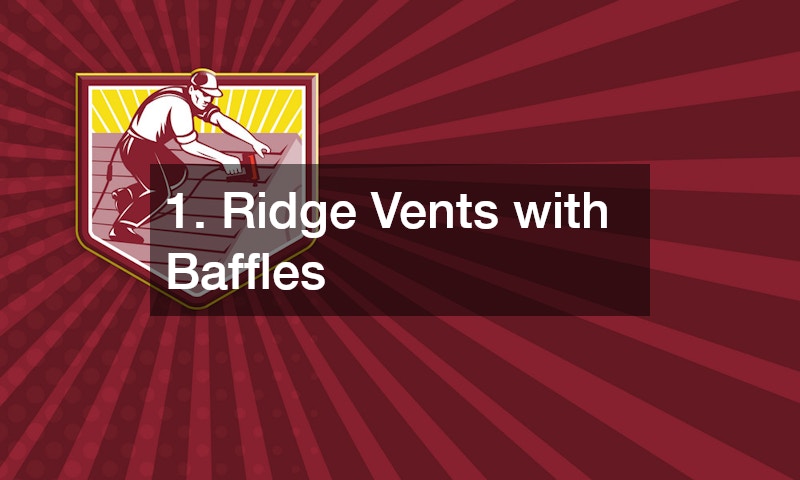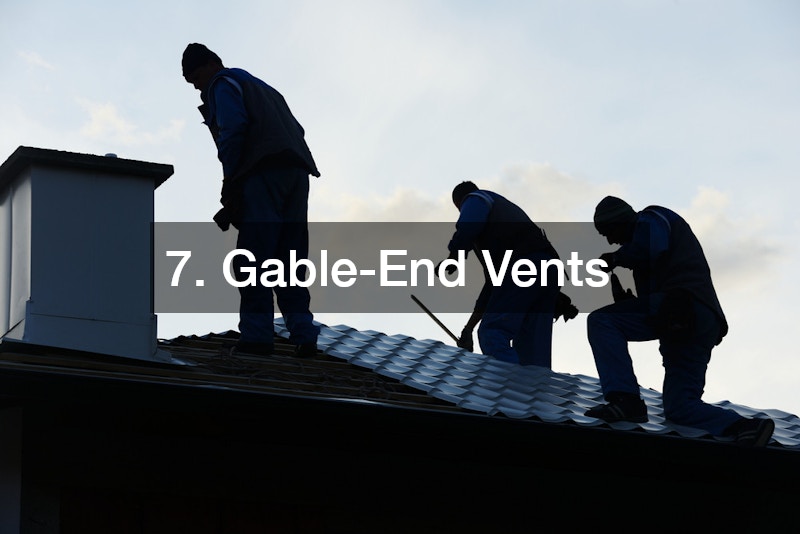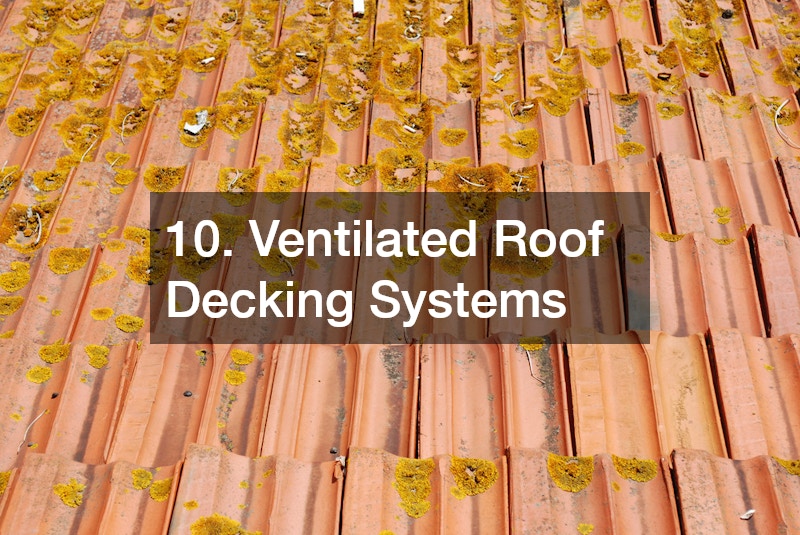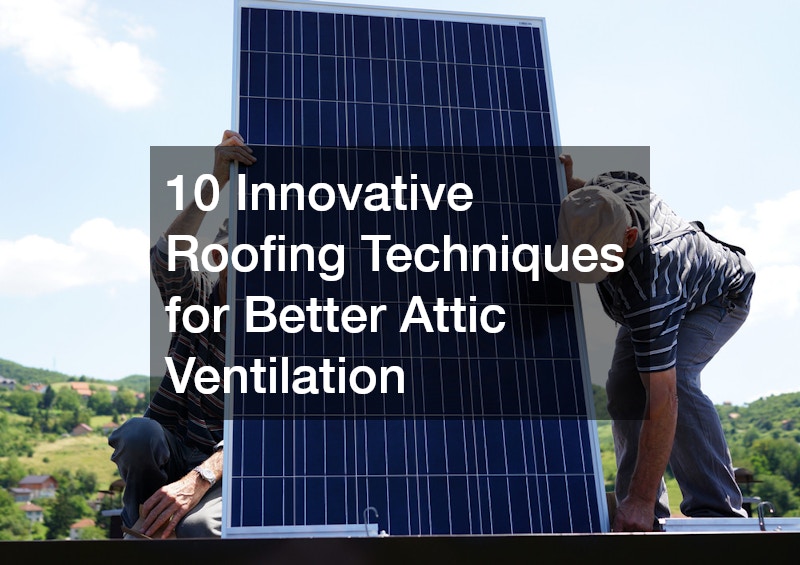Proper roof ventilation is essential for maintaining the durability and longevity of a roof. Without adequate ventilation, heat and moisture can build up in the attic, leading to various issues such as mold growth, shingle damage, and energy inefficiency. In this article, we will explore ten different roofing techniques that help improve ventilation in residential properties.
1. Ridge Vents with Baffles

One effective roofing technique is the installation of ridge vents with baffles. These vents are installed along the peak of the roof and work in conjunction with soffit vents to allow hot air to escape from the attic while drawing in cooler air from outside. This convection process helps regulate the temperature in the attic and prevent moisture buildup, making it an essential roofing technique for any property.
Roof contracting professionals often recommend ridge vents with baffles for their effectiveness in maintaining a balanced attic temperature and reducing the strain on HVAC systems. By incorporating this ventilation technique into a roofing project, homeowners can enjoy improved indoor comfort and lower energy bills.
When considering roof ventilation options, homeowners should consult with reputable residential roofing companies to ensure proper installation and optimal performance. Ridge vents with baffles are a cost-effective solution that offers long-term benefits for the overall health of the roof and property.
2. Solar-Powered Attic Fans
Solar-powered attic fans are another popular roofing technique for enhancing ventilation in residential properties. These fans are powered by solar energy and help expel hot air from the attic, reducing the temperature inside the living space and preventing heat-related damage to the roof and shingles. By harnessing the power of the sun, these fans provide a sustainable and energy-efficient solution for improving indoor comfort.
Professional roofers often recommend the installation of solar-powered attic fans as part of a comprehensive ventilation system. These fans can be strategically placed on the roof to maximize airflow and create a more comfortable environment inside the home. With the assistance of reliable roofing company experts, homeowners can benefit from enhanced ventilation and increased energy savings.
When investing in solar-powered attic fans, homeowners should work with experienced residential roofing companies that specialize in energy-efficient solutions. By incorporating these fans into their roofing project, homeowners can enjoy a more sustainable and environmentally friendly living space.
3. Smart Ventilation Systems
Smart ventilation systems are an innovative solution for enhancing roof ventilation and improving energy efficiency in residential properties. These systems utilize sensors and smart technologies to automatically adjust airflow based on the prevailing weather conditions and indoor temperature. By optimizing ventilation in real time, smart systems help maintain a consistent and comfortable environment inside the home.
Professional roofers often recommend smart ventilation systems for their ability to adapt to changing environmental factors and ensure optimal airflow throughout the year. These systems can be customized to meet the specific needs of a property, providing homeowners with a convenient and energy-efficient solution for roof ventilation. By working with a reliable roofing company, homeowners can enjoy the benefits of a smart ventilation system tailored to their unique requirements.
When considering smart ventilation systems, homeowners should consult with reputable roofing services providers that offer expertise in advanced technology solutions. By investing in a smart system, homeowners can improve indoor air quality, reduce energy consumption, and enhance the overall comfort of their living space with these roofing techniques.
4. Continuous Soffit Vents

Continuous soffit vents are a fundamental component of an effective roof ventilation system. These vents are installed along the eaves of the roof and allow fresh air to enter the attic, while expelling hot and humid air through ridge vents or gable-end vents. By creating a continuous airflow, soffit vents help regulate the temperature in the attic and prevent moisture buildup, reducing the risk of mold growth and structural damage.
Roof repairs and maintenance often involve inspecting and ensuring the proper functioning of soffit vents to maintain a healthy attic environment. Professional roofers recommend incorporating continuous soffit vents into roofing projects to maximize ventilation and enhance the overall performance of the roof with helpful roofing techniques. With regular maintenance and inspection, homeowners can prevent costly repairs and prolong the lifespan of their roof.
When installing continuous soffit vents, homeowners should seek the expertise of local roofers who specialize in ventilation solutions. By working with experienced professionals, homeowners can ensure the proper design and installation of soffit vents, creating a balanced and efficient ventilation system for their property.
5. Turbine Vents (Whirlybirds)
Turbine vents, also known as whirlybirds, are a popular ventilation solution for residential properties with low-pitched roofs. These vents are installed on the roof and utilize wind power to create airflow in the attic, expelling hot air and moisture while drawing in cooler air from outside. Turbine vents are a cost-effective and energy-efficient option for improving roof ventilation and maintaining a healthy attic environment.
Local roofers often recommend the installation of turbine vents as part of a comprehensive ventilation system to enhance the overall performance of the roof. These vents can be strategically placed to maximize airflow and create a more comfortable living space for homeowners. By incorporating turbine vents into their roofing project, homeowners can benefit from improved indoor air quality and reduced energy consumption.
When considering turbine vents, homeowners should consult with local residential roofers who have experience in ventilation solutions. By working with professionals who understand the unique requirements of their property with varied roofing techniques, homeowners can ensure the proper installation and functionality of turbine vents for optimal ventilation performance.
6. Insulation and Ventilation Combinations
Combining insulation with ventilation is a key strategy for maintaining a well-ventilated and energy-efficient roof. Proper insulation helps reduce heat transfer and energy loss, while effective ventilation ensures adequate airflow and temperature regulation in the attic. By integrating insulation and ventilation techniques, homeowners can create a balanced and sustainable roofing system that provides long-term benefits.
Roofing services providers often recommend insulation and ventilation combinations for maximizing the energy efficiency and comfort of residential properties. These solutions help reduce heating and cooling costs, prevent moisture-related issues, and extend the lifespan of the roof. By investing in a comprehensive insulation and ventilation system, homeowners can enjoy a more comfortable and environmentally friendly living space.
When upgrading their roof, homeowners should collaborate with professional roofers who specialize in insulation and ventilation solutions. By incorporating these roofing techniques into their roofing project, homeowners can improve indoor comfort, reduce energy consumption, and enhance the overall performance and durability of their roof.
7. Gable-End Vents

Gable-end vents are a practical ventilation solution for properties with gable roofs. These vents are installed at the ends of the gable walls and provide an outlet for hot air and moisture to escape from the attic. By combining gable-end vents with soffit vents or ridge vents, homeowners can create a continuous airflow that helps regulate the temperature and humidity in the attic.
Local residential roofers often recommend the installation of gable-end vents to improve ventilation and prevent condensation and mold growth in the attic. These vents can be customized to match the aesthetic and functional requirements of the property, providing homeowners with a seamless and effective ventilation solution. Gable-end vents also help reduce attic heat buildup in the summer, which can lessen the strain on air conditioning systems. In colder months, they assist in minimizing moisture accumulation that can contribute to wood rot or insulation damage. Some vents come with integrated screens to keep out pests while still allowing maximum airflow. By incorporating gable-end vents into their roofing project, homeowners can enhance the performance and longevity of their roof.
When considering gable-end vents, homeowners should consult with local roofing contractors who have experience in ventilation solutions for gable roofs. Contractors can assess attic airflow needs and determine the best vent size and placement for the structure. Proper installation is crucial to avoid air circulation imbalances that could hinder effectiveness. By working with professionals who understand the unique challenges of their property in terms of roofing techniques, homeowners can ensure the proper design and installation of gable-end vents for optimal ventilation and moisture control.
8. Passive Ventilation Using Roof Louvers
Passive ventilation utilizing roof louvers is a simple and effective method for improving roof ventilation in residential properties. Roof louvers are installed on the roof and provide a passive airflow solution for expelling hot air and humidity from the attic. These vents work in concert with soffit vents or ridge vents to create a balanced airflow system that promotes optimal ventilation and temperature control.
Local roofing contractors often recommend passive ventilation through roof louvers for its affordability and ease of installation. These vents require no power source and rely on natural convection to maintain a consistent airflow in the attic. By incorporating roof louvers into their roofing system, homeowners can enjoy improved indoor comfort and reduced energy costs.
When installing roof louvers, homeowners should seek the expertise of a local roofing contractor who specializes in passive ventilation solutions. By working with professionals who understand the importance of proper ventilation in terms of roofing techniques, homeowners can ensure the longevity and performance of their roof by preventing heat-related damage and moisture buildup.
9. Cupola Vents for Style and Function
Cupola vents offer both style and function as a unique and decorative ventilation solution for residential properties. These vents are installed on top of the roof and provide an architectural accent while allowing hot air to escape from the attic. Cupola vents come in a variety of designs and materials, adding a touch of elegance to the roof while enhancing ventilation and airflow.
Roof installation experts often recommend cupola vents for their aesthetic appeal and functional benefits in maintaining a well-ventilated attic. These vents can be customized to match the design and style of the property, creating a seamless and visually appealing roof ventilation solution. By incorporating cupola vents into their roofing project, homeowners can enjoy improved indoor air quality and enhanced curb appeal.
When investing in cupola vents, homeowners should consult with local roofing companies that specialize in custom ventilation solutions. By working with professionals who understand the importance of combining style with function in terms of roofing techniques, homeowners can elevate the aesthetics and performance of their roof through the installation of cupola vents.
10. Ventilated Roof Decking Systems

Ventilated roof decking systems are an advanced roofing technique that combines roof ventilation with structural support. These systems feature a specially designed decking material that allows air to flow freely between the roof shingles and the attic space. By promoting ventilation at the decking level, homeowners can prevent moisture buildup, reduce heat transfer, and prolong the lifespan of the roof with these roofing techniques.
Local roofing companies often recommend ventilated roof decking systems for their ability to improve energy efficiency and prevent roof damage caused by thermal expansion. These systems are designed to withstand various weather conditions and provide continuous airflow for optimal ventilation and temperature regulation. They can also help reduce the strain on HVAC systems during hot summer months, potentially lowering energy bills. Additionally, improved airflow can prevent ice damming in colder climates, which protects both the roof structure and interior ceilings from water damage. Some manufacturers offer systems with integrated radiant barriers for added thermal resistance. By investing in a ventilated roof decking system, homeowners can enjoy a durable and energy-efficient roofing solution.
When considering a ventilated roof decking system, homeowners should consult with local roofing companies that specialize in innovative ventilation solutions. A professional assessment can help determine whether your existing roof structure is compatible with this system or if modifications are needed. Proper installation is key to maximizing performance, as any gaps or misalignments can compromise airflow. By working with experienced professionals, homeowners can ensure the proper installation and functionality of a ventilated roof decking system that enhances the performance and longevity of their roof.
Proper roof ventilation is essential for maintaining a healthy and energy-efficient living space. By incorporating various roofing techniques such as ridge vents with baffles, solar-powered attic fans, and smart ventilation systems, homeowners can enhance indoor comfort, reduce energy costs, and prolong the lifespan of their roof. Whether utilizing continuous soffit vents, turbine vents, or cupola vents, it is crucial to work with professional roofers who specialize in ventilation solutions to ensure optimal performance and longevity. By investing in innovative ventilation techniques, homeowners can create a sustainable and comfortable environment inside their home.



